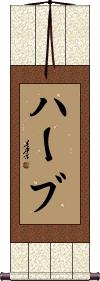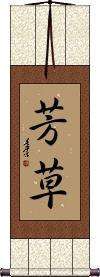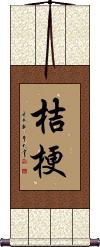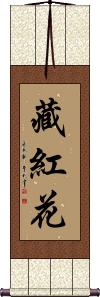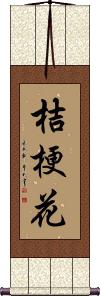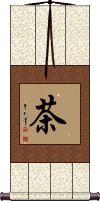Many custom options...
And formats...

Herb in Chinese / Japanese...
Buy a Herb calligraphy wall scroll here!
Personalize your custom “Herb” project by clicking the button next to your favorite “Herb” title below...
Herb
Fragrant Herb / Housou
Bellflower / Herb of Bellflower
桔梗 means “Chinese bellflower” in Japanese.
In Chinese, it refers to the “Platycodon grandiflorus” (Platycodon grandiflorum), “balloon flower,” or “bellflower.”
Please note that in Chinese, this particular 2-character title suggests that you are talking about the medicinal herb derived from the stem of this flower/plant.
Saffron
Bellflower
桔梗花 means “Chinese bellflower” in Japanese.

桔梗花 is the three-character version of this title, which suggests that you are talking about the flower and not the medicinal herb derived from this kind of plant.
茶 means tea. It can refer to prepared tea (ready-to-drink) or dry tea leaves.
The origin of tea is China but the same character is used in Japanese Kanji, and old Korean Hanja with the exact same meaning. Japanese and Korean even borrowed the pronunciation from Chinese (pronounced “cha” in all three languages).
It's said that an early doctor (or herbologist) in ancient China kept poisoning himself as he tried different new herb concoctions. He invented tea as a means to detoxify himself as he recovered from 1 of the 76 times he nearly poisoned himself to death. Tea is seen not just as a drink but as a form of medicine used to remove impurities from the body.
The word “chai” (used in many languages to refer to various teas) is derived from this Chinese word.
茶 also means camellia, as Asian teas are often based on the leaves of camellia plant varieties.
These search terms might be related to Herb:
Basil
Parsley
Rosemary
Sage
Teacher / Master / Old Sage
Tetsu / Wise Sage
Thyme
Not the results for Herb that you were looking for?
Below are some entries from our dictionary that may match your Herb search...
| Characters If shown, 2nd row is Simp. Chinese |
Pronunciation Romanization |
Simple Dictionary Definition |
芳草 see styles |
housou / hoso ほうそう |
More info & calligraphy: Fragrant Herb / Housou |
アンジェリカ see styles |
anjerika アンジェリカ |
More info & calligraphy: Anjelica |
艸 草 see styles |
cǎo cao3 ts`ao tsao takakusa たかくさ |
variant of 草[cao3] (1) kanji "grass radical" (radical 140); (2) grass crown; (out-dated kanji) (1) grass; weed; herb; thatch; (2) (archaism) ninja; (prefix) (3) not genuine; substandard; (surname) Takakusa |
芕 see styles |
suī sui1 sui |
a kind of medicinal herb |
芞 see styles |
qì qi4 ch`i chi |
a kind of aromatic herb (old) |
苙 see styles |
lì li4 li oro おろ |
(herb); pigsty (surname) Oro |
荼 see styles |
tú tu2 t`u tu daka |
thistle; common sowthistle (Sonchus oleraceus); bitter (taste); cruel; flowering grass in profusion A bitter herb; weeds; to encroach; translit. da, dha, dhya, dhu. |
萐 see styles |
shà sha4 sha |
(auspicious herb) |
蒄 see styles |
guān guan1 kuan |
(herb mentioned in ancient texts) |
蒗 see styles |
làng lang4 lang |
(herb); place name |
蓸 see styles |
cáo cao2 ts`ao tsao |
(a kind of herb) |
蔙 see styles |
xuàn xuan4 hsüan |
(herb) |
蕶 see styles |
líng ling2 ling |
withered (plant, herb etc) |
薄 see styles |
bò bo4 po haku はく |
see 薄荷[bo4 he5] (prefix) light (e.g. colour, color); (surname) Haku Thin, poor, shabby: to slight, despise; to reach to; the herb mint. |
薌 芗 see styles |
xiāng xiang1 hsiang |
aromatic herb used for seasoning; variant of 香[xiang1] |
蘄 蕲 see styles |
qí qi2 ch`i chi |
(herb); implore; pray; place name |
蘺 蓠 see styles |
lí li2 li |
red algae; Gracilaria, several species, some edible; Japanese ogonori; arch. used for vanilla-like herb |
蘻 see styles |
jì ji4 chi |
a kind of herb (old) |
鄿 see styles |
qí qi2 ch`i chi |
(herb); place name |
三七 see styles |
sān qī san1 qi1 san ch`i san chi mina みな |
pseudoginseng (Panax pseudoginseng), hemostatic herb (female given name) Mina |
仙草 see styles |
xiān cǎo xian1 cao3 hsien ts`ao hsien tsao sensou / senso せんそう |
medicinal herb (genus Mesona); grass jelly Chinese mesona (Platostoma palustre); (given name) Sensou |
埃蕾 see styles |
āi lěi ai1 lei3 ai lei |
centaury herb with flowers (TCM); Herba Centaurii altaici cum flore |
娑呵 see styles |
suō hē suo1 he1 so ho shaka |
sahā, a herb in the Himālayas imparting immortality to the finder, v. 娑婆. |
当帰 see styles |
touki; touki / toki; toki とうき; トウキ |
(1) (kana only) dong dang gui (aromatic herb similar to dong quai, Angelica acutiloba); (2) (rare) (See 唐当帰) dong quai (aromatic herb used to treat various gynecological symptoms, Angelica sinensis) |
木香 see styles |
mù xiāng mu4 xiang1 mu hsiang mokukoo もくこお |
costus root (medicinal herb); aucklandia; Saussurea costus; Dolomiaea souliei (1) Indian costus (Dolomiaea costus); (2) costus root (used in traditional Chinese medicine); (surname) Mokukoo 根香; 薰陸香; 多伽羅 tagara. An incense-yielding tree, putchuk; vangueria spinosa or tabernae montana coronaria; Eitel. |
洋蘇 洋苏 see styles |
yáng sū yang2 su1 yang su |
sage (herb) |
涼茶 凉茶 see styles |
liáng chá liang2 cha2 liang ch`a liang cha |
Chinese herb tea |
生藥 生药 see styles |
shēng yào sheng1 yao4 sheng yao |
unprocessed medicinal herb |
祥草 see styles |
xiáng cǎo xiang2 cao3 hsiang ts`ao hsiang tsao shōsō |
The felicitous herb, or grass, that on which the Buddha sat when he attained enlightenment. |
肥膩 肥腻 see styles |
féi nì fei2 ni4 fei ni hiji |
(of foods) fatty; greasy A grass or herb said to enrich the milk of cattle. |
Click here for more Herb results from our dictionary
The following table may be helpful for those studying Chinese or Japanese...
| Title | Characters | Romaji (Romanized Japanese) | Various forms of Romanized Chinese | |
| Herb | ハーブ | haabu / habu | ||
| Fragrant Herb Housou | 芳草 | housou / hoso | ||
| Bellflower Herb of Bellflower | 桔梗 | ki kyou / kikyou / ki kyo | jié gěng / jie2 geng3 / jie geng / jiegeng | chieh keng / chiehkeng |
| Saffron | 藏紅花 藏红花 | zàng hóng huā zang4 hong2 hua1 zang hong hua zanghonghua | tsang hung hua tsanghunghua |
|
| Bellflower | 桔梗花 | ki kyou bana kikyoubana ki kyo bana | jié gěng huā jie2 geng3 hua1 jie geng hua jiegenghua | chieh keng hua chiehkenghua |
| Tea | 茶 | cha | chá / cha2 / cha | ch`a / cha |
| In some entries above you will see that characters have different versions above and below a line. In these cases, the characters above the line are Traditional Chinese, while the ones below are Simplified Chinese. | ||||
Successful Chinese Character and Japanese Kanji calligraphy searches within the last few hours...
